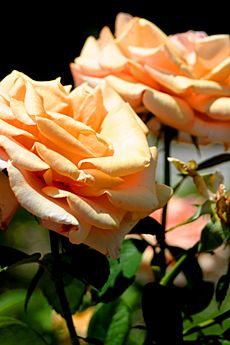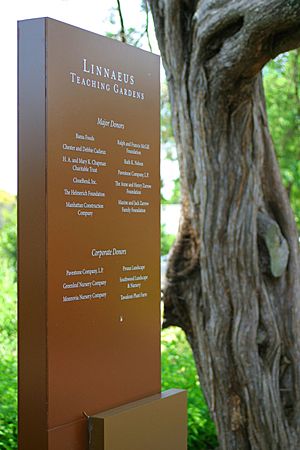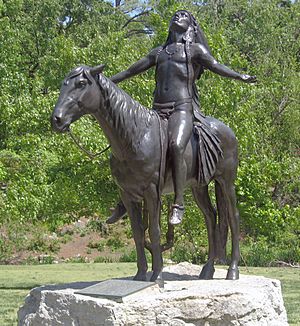Woodward Park (Tulsa) facts for kids
Quick facts for kids |
|
|
Woodward Park and Gardens Historic District
|
|
|
Invalid designation
|
|
| Location | 2324 S. Rockford, Tulsa, Oklahoma |
|---|---|
| Built | 1933 - 1934 |
| Architect | G. Burton Fox |
| NRHP reference No. | 14000054 |
| Added to NRHP | March 11, 2014 |
Woodward Park is a large public park in Tulsa, Oklahoma. It covers about 45 acres. It's not just a park; it's also a botanical garden and an arboretum. This means it has many different kinds of plants and trees for people to enjoy and learn about.
The park is located between 21st and 24th Streets. It's known for its amazing collections of flowers. You can find azaleas, tulips, irises, dogwoods, and redbuds here. The park also has special areas like the Tulsa Rose Garden and the Tulsa Garden Center.
Woodward Park was named after Helen Woodward, who originally owned the land. It officially became a park in 1929. Because of its special design and history, it was added to the National Register of Historic Places in 2014. This means it's recognized as an important historical site.
Contents
- Park History and Design
- Tulsa Rose Garden
- Anne Hathaway Herb Garden
- Rock Gardens
- Tulsa Arboretum
- Linnaeus Teaching Garden
- Tulsa Garden Center (David R. Travis Mansion)
- Tulsa Historical Society Building (Samuel Travis Mansion)
- Appeal to the Great Spirit Statue
- National Register of Historic Places Status
Park History and Design
The city of Tulsa bought the land for Woodward Park in 1909. It was 45 acres and cost $100 per acre. The land was once owned by Helen Woodward, a young Creek Indian girl. Her father sold the land when she was only 14 years old.
Later, in 1925, Helen (then known as Helen Slemp) went to court. She tried to get her land back from the city. The court case lasted four years. In the end, the court decided that the city could keep the land for the park.
After the city officially owned the land, construction began in 1933. Workers from New Deal programs, like the Civil Works Agency, helped build the park. These programs were created during the Great Depression to provide jobs. G. Burton Fox, a landscape artist from Tulsa, designed the park's beautiful layout.
Woodward Park now includes several important areas. These are the Tulsa Rose Garden, the Tulsa Garden Center, the Tulsa Arboretum, and the Linnaeus Teaching Gardens. The Tulsa Historical Society is also nearby, but it's not part of the park itself.
Tulsa Rose Garden
The Tulsa Municipal Rose Garden started in 1935. It was another project built by workers from the Works Progress Administration (WPA). This garden was designed with five levels, or terraces. These terraces were built on a hillside using manual labor and horses.
The terraces have stone walls and steps, covered with English Ivy. The Tulsa Garden Society says the Rose Garden has about 5,000 rose plants. These plants represent 250 different kinds of roses.
This rose garden is one of the most famous parts of Woodward Park. In 1937, a magazine called Better Homes and Garden gave an award to the Tulsa Garden Club for their work on the garden.
Recently, a plant virus called rose rosette has affected the roses. This virus is carried by tiny mites that fly in the wind. By 2014, the virus had killed almost two-thirds of the rose plants. Park experts plan to plant new types of roses in 2015 that can resist the virus better. They will also add other kinds of plants to keep the garden beautiful.
Anne Hathaway Herb Garden
The Anne Hathaway Herb Garden was started in 1939. A Tulsa resident named Jewel Huffman and the Anne Hathaway Herb Garden Club helped create it. Both the garden and the club were named after Anne Hathaway. She was the wife of the famous English writer William Shakespeare. She was known for loving gardening and growing herbs for cooking.
The Anne Hathaway Herb Garden Club took care of the garden until 1982. After that, the Tulsa Parks Department took over its care. The garden has many different herbs. Some examples include geraniums, sages, mints, basil, rosemary, and oregano.
Rock Gardens
The Upper and Lower Rock Garden areas were made in 1930. They are located north of the herb garden. The Upper Rock Garden uses special honeycomb limestone rocks. These rocks are placed to look like a small stream with springs.
This area has a rock walkway, benches, fountains, and bridges. Flowers are planted here all year round, so there's always something blooming. The Lower Rock Garden was planted in the 1960s and 1970s. It has a very large number of azalea plants. These plants usually bloom between mid-March and mid-April. When they bloom, they create a huge burst of color.
Tulsa Arboretum
The Tulsa Arboretum is a special part of Woodward Park. It covers about 3 acres. This area has 270 different kinds of shrubs and trees. All of these plants are native to Oklahoma, meaning they naturally grow in the state.
The arboretum is a popular place for people to walk their dogs. However, dogs must always be on a leash. This rule helps keep the plants and other visitors safe.
Linnaeus Teaching Garden
In 2005, the Parks Department approved a new garden project. It was the Linnaeus Teaching Garden, covering 1.5 acres. This garden is part of the Tulsa Garden Center's programs.
The main goal of the Linnaeus Teaching Garden is to help people learn. It shows homeowners how to grow flowers, vegetables, shrubs, and groundcovers successfully at their own homes. The garden was named after Carl Linnaeus, a famous Swedish botanist. It was officially opened on June 8, 2006.
Tulsa Garden Center (David R. Travis Mansion)
The building that now houses the Tulsa Garden Center was once a mansion. It was built in 1919 by David R. Travis. The 21-room house was located just south of the Tulsa Rose Garden. It sat on a 13-acre piece of land.
A man named J. Arthur Hull bought the property in 1923. He added a conservatory and a garden to the mansion. Later, in 1954, William Skelly sold the property to the city. The city then added this land to Woodward Park. It became a place for learning and meetings for groups interested in plants and the environment.
Tulsa Historical Society Building (Samuel Travis Mansion)
Samuel Travis, David's brother, built his mansion right next to David's estate. Both houses were designed by the same architect at the same time. Samuel's house was on a 3.2-acre lot.
It remained a private home until 1997. That year, the Tulsa Historical Society (THS) bought it. They used money from the Tulsa Tribune foundation to buy it. Before the sale, a developer wanted to tear down the mansion and build houses. The THS saved the mansion and made it into an office and museum. They added a new wing to the original building. The museum officially opened on January 28, 2008.
Appeal to the Great Spirit Statue
There is a famous statue in Woodward Park called Appeal to the Great Spirit. It was made by sculptor Cyrus Dallin. A smaller plaster version of this statue was given to Tulsa Central High School in 1923. It stayed in the school until 1976 when the school closed.
The plaster statue was then moved to the new Central High School. It is still there today. The full-size bronze statue in Woodward Park was made using the plaster version as a model. It was placed in the park in 1985.
National Register of Historic Places Status
Woodward Park was officially added to the National Register of Historic Places on March 11, 2014. It is listed as the Woodward Park and Gardens Historic District. This recognition highlights its importance in several areas. These include its beautiful landscape design, its architecture, and its role in education and recreation.




